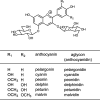Tracing the genealogy of research on the mechanism of blue flower coloration by anthocyanin based on Keita Shibata's work
- PMID: 39401899
- PMCID: PMC11535004
- DOI: 10.2183/pjab.100.028
Tracing the genealogy of research on the mechanism of blue flower coloration by anthocyanin based on Keita Shibata's work
Abstract
K. Shibata is the ancestor of the research on anthocyanins in Japan and proposed metal complex theory against the pH theory by R. Willstätter. Shibata's successors, S. Hattori and K. Hayashi, made efforts to clarify blue flower coloration by metal complexation and found commelinin, a self-assembled supramolecular metal complex pigment, in blue dayflower, Tsuyukusa. The author introduces two key reports on blue flower coloration published in the Proceedings of the Japan Academy and describes the subsequent development of the study.
Keywords: anthocyanin; blue flower coloration; commelinin; crystallographic analysis; metalloanthocyanin.
Figures








Similar articles
-
Cyanosalvianin, a supramolecular blue metalloanthocyanin, from petals of Salvia uliginosa.Phytochemistry. 2008 Dec;69(18):3151-8. doi: 10.1016/j.phytochem.2008.03.015. Epub 2008 May 6. Phytochemistry. 2008. PMID: 18466933
-
Achievements and perspectives in biochemistry concerning anthocyanin modification for blue flower coloration.Plant Cell Physiol. 2015 Jan;56(1):28-40. doi: 10.1093/pcp/pcu097. Epub 2014 Jul 10. Plant Cell Physiol. 2015. PMID: 25015943 Review.
-
Chemical and biological study of flavonoid-related plant pigment: current findings and beyond.Biosci Biotechnol Biochem. 2024 Jun 21;88(7):705-718. doi: 10.1093/bbb/zbae048. Biosci Biotechnol Biochem. 2024. PMID: 38632052 Review.
-
Generation of blue chrysanthemums by anthocyanin B-ring hydroxylation and glucosylation and its coloration mechanism.Sci Adv. 2017 Jul 26;3(7):e1602785. doi: 10.1126/sciadv.1602785. eCollection 2017 Jul. Sci Adv. 2017. PMID: 28782017 Free PMC article.
-
Ferric ions involved in the flower color development of the Himalayan blue poppy, Meconopsis grandis.Phytochemistry. 2006 May;67(10):992-8. doi: 10.1016/j.phytochem.2006.03.013. Epub 2006 May 6. Phytochemistry. 2006. PMID: 16678868
References
-
- Hayashi, K. (ed.) (1988) Plant Pigments-An Introduction to Research and Experiments (Revised and Enlarged Edition) [植物色素 実験・研究への手引き 増訂]. Yokendo, Tokyo (in Japanese).
-
- Goto T., Kondo T. (1991) Structure and molecular stacking of anthocyanins-flower color variation. Angew. Chem. Int. Ed. Engl. 30, 17–33.
-
- Brouillard, R. and Dangles, O. (1994) The Flavonoids Advances in Research since 1986 (ed. J.B. Harborne). Chapman & Hall, London, pp. 565-588.
-
- Yoshida K., Mori M., Kondo T. (2009) Blue flower color development by anthocyanins: From chemical structure to cell physiology. Nat. Prod. Rep. 26, 884–915. - PubMed
-
- Pina F., Melo M.J., Laia C.A.T., Parola A.J., Lima J.C. (2012) Chemistry and applications of flavylium compounds: A handful of colours. Chem. Soc. Rev. 41, 869–908. - PubMed

